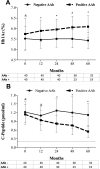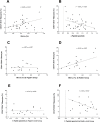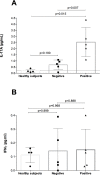Pancreatic autoantibodies and CD14+CD16+ monocytes subset are associated with the impairment of ß-cell function after simultaneous pancreas-kidney transplantation
- PMID: 30794611
- PMCID: PMC6386378
- DOI: 10.1371/journal.pone.0212547
Pancreatic autoantibodies and CD14+CD16+ monocytes subset are associated with the impairment of ß-cell function after simultaneous pancreas-kidney transplantation
Abstract
Pancreatic autoantibodies (AAb) has been associated with a worse pancreas graft survival after simultaneous pancreas-kidney transplantation (SPK). However, due to the variable time for AAb to become positive and the lack of early biomarkers suggesting such autoimmune activation, the mechanisms leading ß-cell destruction remain uncertain. The present study aimed to evaluate the association between post-transplant AAb and the functional impairment of the pancreatic ß-cell and also the association of such AAb with inflammation after SPK. In a longitudinal study, we analyzed the impact of post-transplant glutamic acid decarboxylase (GAD-65) and the insulinoma-associated autoantigen 2 (IA-2) AAb on pancreas graft function. Serum Hb1Ac and C-peptide (C-pep) were longitudinally compared between a group with positive posttransplant AAb (AAb+; n = 40) and another matched group with negative AAb (AAb-; n = 40) until the fifth year following seroconversion. In the cross-sectional analysis, we further evaluated the systemic signatures of inflammation by measuring pro-inflammatory CD14+CD16+ monocytes by flow-cytometry and interleukin 17-A serum levels in 38 SPK recipients and ten healthy controls. In the longitudinal study, patients with AAb+ showed higher levels of Hb1Ac (p<0.001) and lower C-pep levels (p<0.001) compared to those who remained AAb- throughout the follow-up. In the cross-sectional study, AAb+ patients showed a higher percentage of CD14+CD16+ monocytes compared with those with AAb- and the healthy controls (6.70±4.19% versus 4.0±1.84% and 3.44±0.93%; p = 0.026 and 0.009 respectively). Also, CD14+CD16+ monocytes correlated with Hb1Ac and C-pep serum levels. Multivariate logistic regression showed that posttransplant AAb+ was independently associated with a higher percentage of pro-inflammatory monocytes (adjusted-OR 1.59, 95%CI 1.05-2.40, p = 0.027). The group of patients with positive AAb also showed higher levels of IL17A as compared with the other groups (either healthy control or the negative AAb subjects). In conclusion, pancreatic AAb+ after SPK were not only associated with higher Hb1Ac and lower c-peptide serum levels but also with an increased percentage of CD14+CD16+ monocytes and higher levels of circulating IL17-A.
Conflict of interest statement
The authors have declared that no competing interests exist.
Figures




Similar articles
-
Tyrosine-phosphatase and glutamate-decarboxylase antibodies after simultaneous pancreas kidney transplantation: do they have an impact on pancreas graft survival?Transplant Proc. 2015 Jan-Feb;47(1):107-11. doi: 10.1016/j.transproceed.2014.11.011. Transplant Proc. 2015. PMID: 25645784
-
Impact of Pancreatic Autoantibodies in Pancreas Graft Survival After Pancreas-Kidney Transplantation.Transplant Proc. 2020 Jun;52(5):1370-1375. doi: 10.1016/j.transproceed.2020.02.035. Epub 2020 Mar 31. Transplant Proc. 2020. PMID: 32245621
-
Pancreatic autoantibodies after pancreas-kidney transplantation - do they matter?Clin Transplant. 2014 Apr;28(4):462-9. doi: 10.1111/ctr.12337. Epub 2014 Mar 21. Clin Transplant. 2014. PMID: 24655222 Clinical Trial.
-
A shift towards pro-inflammatory CD16+ monocyte subsets with preserved cytokine production potential after kidney transplantation.PLoS One. 2013 Jul 29;8(7):e70152. doi: 10.1371/journal.pone.0070152. Print 2013. PLoS One. 2013. PMID: 23922945 Free PMC article.
-
CUZD1 and anti-CUZD1 antibodies as markers of cancer and inflammatory bowel diseases.Clin Dev Immunol. 2013;2013:968041. doi: 10.1155/2013/968041. Epub 2013 Apr 22. Clin Dev Immunol. 2013. PMID: 23710207 Free PMC article. Review.
References
Publication types
MeSH terms
Substances
LinkOut - more resources
Full Text Sources
Medical
Research Materials
Miscellaneous

